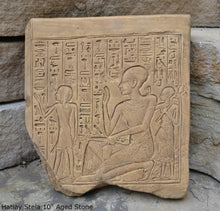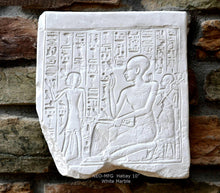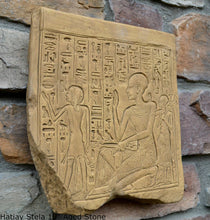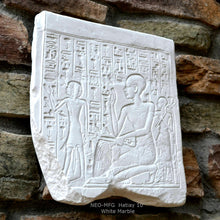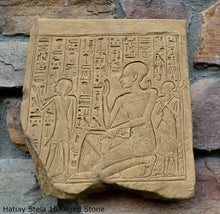
History Egyptian Hatiay Stela Fragment Sculptural wall relief plaque www.Neo-Mfg.com 10"
From Metropolotian Museum art
Period:New Kingdom
Dynasty:Dynasty 18
Date:ca. 1336–1295 B.C.
Geography:From Egypt, Memphite Region, Saqqara
Medium:Limestone
Dimensions:H. 25 cm (9 13/16 in), w. 23 cm (9 1/16 in)
Credit Line:Rogers Fund, 1955
Original piece was part of a larger scene from the morturary chapel and was carved out of limestone in ancient Saqqara just south of modern day Cairo.
Hatiay Stela Egyptian 18th-19th dynasty. Magnificent reproduction of the limestone fragment portrays Hatiay, kneeling holding a censor and libation vase. Accompanied by his son Ptahmose
The third figure, a priest wearing a panther skin and side lock, recites the prayer inscribed above the figures, which asks Sokar-Osiris to grant funerary offerings - "a thousand of each kind enumerated" - to Hatiay
The elongated heads of Hatiay and his son, their costumes and the treatment of their bodies are typical of the late Amarna period (1330B.C.)
https://www.metmuseum.org/art/collection/search/549363
We offer many custom color finishes like Silver Leaf, Bronze, Bronze with Patina, Aged stone, Pewter, Copper
All finishes are Faux finish, each piece of art is hand made and no two (2) pieces are the same. The color shown by camera and on the digital display may look different in real life. Lighting, surrounding colors, time of day, electronic display etc will change true life colors.
www.NEO-MFG.com





